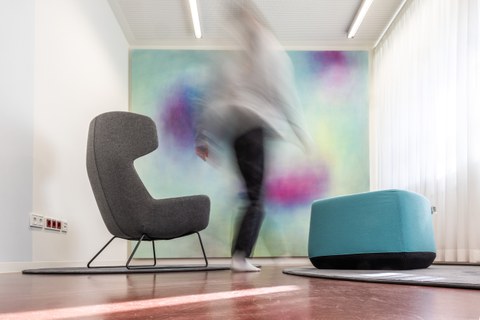Retreat

Raum der Stille Innenbereich
The "Retreat" at TU Dresden offers everyone on campus a place to retreat from the hustle and bustle of everyday life. Whether to pause, gather strength, meditate or pray: In complete silence, university members can leave offices, laboratories and lecture halls behind for a moment of inner contemplation.
Neutrality and openness characterize both the usage concept and the design of the room. The "Retreat" is open to all those seeking peace and quiet as a non-denominational retreat and thus takes account of the diversity lived on campus. The furnishings have been deliberately kept minimalist and uninviting in order to give users as much freedom as possible in designing their quiet time.
The "Retreat" is located in room E78 in the Fritz-Foerster building on the Südvorstadt campus. It is accessible free of charge and barrier-free on weekdays during the opening hours of the ServiceCenterStudium. The room can be used by up to three people at the same time. Reservations are not possible. Please observe and comply with the room regulations. The most important prerequisite for use is mutual consideration and respectful cooperation.
Opening hours
Monday: 08:30 - 16:00
Tuesday: 08:30 - 18:00
Wednesday: 08:30 - 16:00
Thursday: 08:30 - 18:00
Friday: 08:30 - 13:00
In addition to the "Retreat" as a place of deceleration and inner contemplation.
Henning Haupt (*1964 in Itzehoe), painter and Chair of Foundations in Art and Architecture at the Faculty of Architecture at TU Dresden, was commissioned in 2023 to create a large-format painting that takes up the entire front wall of the Room of Silence. The large, almost square format of "Blur of Silence" is defined by flowing color that extends beyond the edges of the painting.
The non-representational work is in the tradition of abstract, lyrical color field painting, which, in contrast to the sacred, generally representational art of past centuries, does not seek to depict a cult of the sacred or mystical per se, but rather aims for a deeper overwhelmingness in the sense of Romanticism, detached from religion and ideology. Landscape, sky, vastness, and thus the sublime and sublime, are at the center of these works.
Henning Haupt, who has been working intensively on pictorial inventions between color, form, surface and space for over 30 years, has applied pigments such as Prussian blue, nickel titanium yellow, titanium white and quinacridone magenta in up to twelve layers to the white primed canvas for "Raum der Stille". The resulting pictorial space knows no foreground, middle ground or background, but it does know infinity when the layers of paint applied with a broad brush combine to form an almost baroque cloud of sky. Natural phenomena and the exploration of the cloudy sky experienced an artistic and scientific heyday with the advent of modernism from 1800 onwards. Clouds also symbolize dreams and longings - the fleeting and impermanent challenge the power of association and imagination.
With "Blur of Silence", Haupt creates a color space removed from the earthly that painterly traces the multicolored potential of clouds and light phenomena. Lightness and sensitivity characterize the transcendent colour field. As a pure impression of light and color, the painting expands the real "space of silence" and invites the viewer to trace the delicate color transitions, the alternation of light and dark and the dynamics of the painterly brushstroke.
The abstract large format "Blur of Silence" by Henning Haupt belongs to the extensive collection cluster of building-related art in the TU Dresden art collection and refers to the close relationship between teaching and art production in Dresden. Since the 19th century, the university art collection and the art on buildings on campus have also reflected the work of professors and artists who taught at TU Dresden and its predecessor institutions.
In addition to the "Room of Silence" as a place to slow down and contemplate, there are a large number of quiet rooms on the main campus and in the TUD's external buildings.
We are delighted that you have used the Room of Silence and would be delighted if you could give us feedback in our virtual guestbook on your initial associations with the room concept. We would like to use the survey to find out how the "Retreat" is used and how it can be developed further.
Your participation is of course voluntary. The survey is anonymous and you can cancel it at any time. Information on data protection can be found here.
The survey is conducted by the Center for Quality Analysis and was commissioned by Directorate 9 University Culture at TU Dresden. If you have any questions, please contact:
